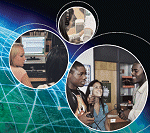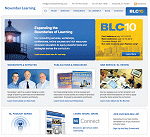Boundless Opportunity
- By Dian Schaffhauser
- 10/01/09
National borders are no match for the reach of online technologies, as
demonstrated by a host of collaborative projects that use web-based platforms
to link US students with their peers abroad.
 THE CONTRAST BETWEEN the videos
couldn't be more different. In one, a group of uniformly
dressed eighth-graders lines up in the Bar-Lev Junior High
School gymnasium in Kfar-Saba, Israel, doing Israeli
dances. In the other, a high school girl in a Washington, DC,
classroom smiles into the camera and calls out, "Hey,
wassup? This is Ballou Senior High School....We got to
show you how we dance!" Then, to the syncopated rhythms
of go-go music, a handful of kids get onto the floor and
move around in a boogie called "Beat Your Feet."
THE CONTRAST BETWEEN the videos
couldn't be more different. In one, a group of uniformly
dressed eighth-graders lines up in the Bar-Lev Junior High
School gymnasium in Kfar-Saba, Israel, doing Israeli
dances. In the other, a high school girl in a Washington, DC,
classroom smiles into the camera and calls out, "Hey,
wassup? This is Ballou Senior High School....We got to
show you how we dance!" Then, to the syncopated rhythms
of go-go music, a handful of kids get onto the floor and
move around in a boogie called "Beat Your Feet."
But that contrast was the point. Two teachers-- English
teacher Hagit Goldstein in Israel and Spanish teacher
Allison Baugher in the US-- were connecting students
through an online classroom network called ePals so their
two classes could express their unique cultures and learn
about music and dance specific to other parts of the world.
The service, which is free to users, provides secure e-mail
that enables students to communicate one-on-one with
each other, blogging capabilities, and a function called
Classroom Match that allows teachers to post or participate
in activities with other classes.
The possibilities for international classroom collaboration
in projects such as this one have never been more
promising. Internet access is nearly ubiquitous in US
schools, and online collaborative tools-- Skype, Google
Docs, Ning, Facebook, TeacherTube, blogs, e-mail, chat
rooms-- are more abundant than ever, rendering borders
and barriers inconsequential.
"You don't need to be talking about anything
important, just learning about the fact that children in other schools
go to class at night or go home at lunch or that they eat something
different, or that everyone has a different way of doing things."
Baugher says she signed up for ePals during the last
couple of weeks of the 2008-2009 year, just before the
beginning of summer break. In the midst of doing a unit on
Latin music, teaching her class dances, instruments, and
music styles, she sent out a message to other teachers on
the site, hoping to find ways for her kids to practice Spanish.
"Then it occurred to me that this would be a good opportunity
for them to express their dance culture," Baugher says.
They made a couple of videos, which she posted to the ePals
projects forum with a note: "This is how we dance in DC."
That post elicited a response from Goldstein with a link to the
video of her eighth-grade students doing their national dance.
Baugher shared the video from Israel with her class. "They
were in uniform; it was all very choreographed," she says.
"[My students] asked me, 'Are these their cheerleaders?' I
said, 'Maybe we should ask them.'"
Meanwhile, Goldstein's students on the other side of the
globe were excited to watch their peers in action, Baugher
adds. "They were familiar with that type of dance, however, by
another name: hip hop."
Go Global: Resources That Can Help
 Asia Society's Partnership for Global
Learning:
A network for educators that
provides professional development,
policymaking, and other materials.
Asia Society's Partnership for Global
Learning:
A network for educators that
provides professional development,
policymaking, and other materials.
CARE's Virtual Field Trips: An online avenue for students to take multiday
tours of multiple countries.
ePals: Multilingual e-mail, blogging, and projects
to connect classes around the world.
Global Stock Market Simulation Challenge: Students can hone skills as
trading managers for global investments.
iEARN: A multilingual site for schools and youth
organizations interested in participating in collaborative projects.
TakingITGlobal: An online community that addresses
international issues for students from ages 13 to 30.
The exchange of videos led to a brief online conversation
in the discussion forum between students in the two classes. The
posts to ePals are moderated and there's a seven-hour difference
in time zones between the two locations, so the correspondence
didn't happen in real time. Students gave their comments to their
teachers, who posted them to the site, then awaited a response.
In spite of the stilted mode of operation in her first ePals
project, Baugher values the service for the connections it can
help her make and the new vistas it brings to her students. "Many of my students haven't traveled far out of DC," she says.
"Working in the type of school I work in, I don't have the opportunity
to bring them out into the world. But the technology
resources allow me to bring the world into the classroom, even
if it's just looking at e-mails or pictures from other students.
"It doesn't need to be face-to-face communication. You don't
need to be talking about anything important, just learning about
the fact that children in other schools go to class at night or
go home at lunch or that they eat something different, or that
everyone has a different way of doing things."
This year Baugher hopes to set up e-mail on ePals to allow
her students personal contact with kids in other countries, as
well as have them create their own blogs on the site.
Goldstein, who has done multiple projects through ePals
since 2005, is already at that stage. Once a week her students
head to the computer lab to communicate with their "ePals."
Her kids have had exchanges with students in North Carolina
about global warming; swapped reflections on Shakespeare's
Romeo and Juliet with students in San Diego; and discussed
cultural differences simultaneously with students in Hong
Kong, South Korea, and Portugal. Even though much of the
contact takes place through such mediums as Skype and
wikis, the initial contact was made via ePals.
"Sharing ideas among pupils from different countries
enhances their English proficiencies, but most of all contributes
to their motivation to study English," says Goldstein.
"They receive authentic information, which they can never
find anywhere else."
'A-ha!' Moments
That exchange of authentic information is also what prompted
Nicolle Boujaber-Diederichs, a social studies teacher at Cypress
Creek High School in Orlando, to join the International
Education and Resource Network (iEARN). The nonprofit
site gives teachers and students in 125 countries a way to connect
online with each other and collaborate on projects that
they design themselves. The current database contains 150
different projects.
Two years ago, Boujaber-Diederichs joined with iEARN
member Said Belgra on a new project the Moroccan teacher had developed called My Identity, Your Identity to encourage
students to explore and research the elements that form their
identities. "He saw the need in Morocco and around the world
for people to go back to their roots and appreciate their traditions
and culture and learn about traditional ways of living in
their own country," she says. The two teachers and their students
created a schedule of themes to pursue every month, such as
dance, music, festivals and holidays, and fashion.
Each day, the US students would log in to the iEARN project
page to get Boujaber-Diederichs' instructions, perhaps to research
and compile materials or to answer a series of questions, all
meant to get them to explore their own cultural experiences.
Their responses would be converted into PowerPoint presentations
and posted to the iEARN platform for sharing with
Belgra's classes in Morocco. That would lead to exchanges on
the site's discussion forums between the two groups of students.
"Often my students would say, 'Wow! We're not so different
from each other,'" Boujaber-Diederichs says. "'They wear
jeans and T-shirts too.' There would be little 'A-ha!' moments
where they'd learn something."
During a 2008 trip to Azerbaijan, the Florida teacher met an
Azerbaijani counterpart, Irada Samadova, who has been doing
projects through iEARN since 2000. As a result of their acquaintance,
Samadova, an English teacher at Zarifa Aliyeva School,
a secondary school in the Azerbaijan capital of Baku, joined the
My Identity, Your Identity project last year. "From my experience,
if you don't have a real partner, the students don't feel like
they're writing for a real audience," Samadova says. "The forums
are loaded with posts that sometimes are not relevant to the project
or have lots of discussions where few people participate."
The posts by Boujaber-Diederichs' students, Samadova says,
provided a firsthand account of American life, versus the impersonal
descriptions her students find in the books they read. She
lists several other outcomes from her class's participation in
iEarn projects: "I introduced my students to project work,
pushed them to plan the time, encouraged them to work together
to process the information from the forum, share the work done,
prepare PowerPoint files, make the presentation in class, and
practice English."
Just this past July, Boujaber-Diederichs and Samadova, while
in Morocco for the annual iEARN international conference,
presented together on My Identity, Your Identity at a Global
Connections and Exchange (GCE) workshop that helped train
teachers to train their colleagues in the use of iEARN. The GCE
is the outgrowth of an initiative called BRIDGE (Building
Respect Through Internet Dialogue and Global Education),
created by iEARN in the wake of the Sept. 11 terrorist attacks
to foster online collaboration between US schools and countries
with heavily Muslim populations. The work of the two educators
made a big impression on the other workshop participants,
bringing a wave of new recruits to the project. Schools in
Bahrain, Oman, the Palestinian territories, Kenya, and Yemen
are among the nations that have committed to join My Identity,
Your Identity for 2009-2010.
While Boujaber-Diederichs is expanding her network outside
of her own country, she sees the need to continue promoting services
such as iEARN to the teachers in her own district. "A lot
of people say, 'It seems so interesting, but I don't have time,'"
she says. Her job is to show them how cross-country projects can
open a wider world to their students and still meet state academic
mandates. "Instead of writing a report for the class to meet
some standard, they're writing a report and then sharing it with
other students in other countries who read it and respond."
Swapping Stories
While acquainting her students with the
Muslim world was a natural result of Boujaber-
Diederichs' work with a Moroccan
teacher, it was the main motivation behind
Liz Carriker's effort to involve her 10th-grade English students
at the Academy of International Studies in Charlotte, NC, in
an online collaborative exercise with schools in Indonesia.
"We have a lot of students who are from Indonesia," Carriker
says of the academy, a 375-student "school within a school"
attached to the comprehensive, 3,000-student Independence
High School. "We have a large Muslim population. About two
years ago, our Muslim students started opening up and sharing
a lot of their culture and a lot of their religion with the other
students without fear of being ridiculed. And there was interest
with the students in learning more about that culture."
That opportunity came via a larger cultural exchange project
called Creative Voices of Islam launched in 2008 by the Asia
Society, a New York City-based organization aimed at strengthening
relationships between Americans and Asians. A part of
that effort includes advancing international education by using
online platforms to connect schools that, like the academy, are
members of the Asia Society's International Studies Schools
Network (ISSN) with high schools in Muslim communities
throughout Asia. Students at the academy, along with those at
an ISSN school in Mathis, TX, and at three schools in the
Indonesian city of Yogyakarta, created and exchanged webbased
multimedia projects that portray the stories of their lives,
revealing themes that are relevant to all.
Carriker observes that the US tends to only relate Islam to
Middle Eastern nations, and the Creative Voices initiative was
a means of undoing that stereotype. "We thought this would
be a great opportunity to actually have primary contact with
another group of students who were Muslim in an area that
students didn't think of being Muslim."
In October 2008, the Asia Society sent Alexis Menten, its
assistant director for after-school and youth leadership, to
Charlotte to work for a week with Carriker and her students, "helping them identify the stories they wanted to tell," Menten
says. "A lot of it was about looking at their identity and how
they wanted to project themselves to students in Indonesia."
The students were broken up into three groups. "In one project,
they decided to show the diversity of the student population at
Independence-- that people are different and yet the same--
through pictures and interviews," Carriker says. A second group
compared the high school as it was in the 1970s to as it is today
through interviews with students and faculty, including about a
half-dozen current staff who once attended the school. The third
group focused on extracurricular activities to show that the high
school is about more than just its renowned football program.
To tell their digital stories,
Carriker's students took photos
and recorded interviews, and then
brought the pieces together using
the open source sound-editing program
Audacity in tandem with Windows Movie Maker to create
a movie. Menten, who provided on-site training at each of the
schools in the program, including those in Indonesia, helped
tutor Carriker's students in the use of the technologies.
Once completed, the projects were posted to the Asia Society
website and viewed by the students at the participating schools,
who then commented on them. "It's insightful to see the reaction
and the understanding that's created among the kids," says Tony
Jackson, the Asia Society's vice president of education. "The
level of storytelling and perception and insight into their communities
that this technology enables is quite amazing."
This year Carriker will have the academy's new videoconferencing
lab to use, which will allow real-time contact between
her students and those abroad, though she doesn't know if the
other Creative Voices schools share that capability. But she
expects to be able to hook up with schools in Japan and China
with which the academy participates in student exchange programs. "We have a teacher who is originally from Turkey and is
going back," she says. "So we're hoping to open up a dialogue
with a school there as well." Menten notes that in addition to
retaining the participants from last year, Creative Voices intends
to expand to schools in Afghanistan and Pakistan next year as
well as to additional schools in the ISSN.
Carriker hopes her students are learning to look beyond their
community, state, and nation to see that they're not alone. "If I
can get a group of students to see that other people are going
through what they are and opening their eyes to the bigger picture,
when they grow up and become citizens they're not going
to perpetuate [stereotypes]," she says. "That's the ultimate goal.
The world has to work together. It's not us and them."
How to Sell Your Students on Global Collaboration
 ALAN NOVEMBER, THE FOUNDER of
November Learning, which provides planning,
workshops, and professional
development consulting to educators,
offers these tips for exciting students
about connecting with their peers
across the world.
ALAN NOVEMBER, THE FOUNDER of
November Learning, which provides planning,
workshops, and professional
development consulting to educators,
offers these tips for exciting students
about connecting with their peers
across the world.
Make them care. If you're a history teacher, use Skype to put your students in touch with UK students and
have a debate on the American Revolution. "If you tell them, 'I'm
going to record it, then I'm going to put it into iTunes, and the whole
world will be able to hear your debate,'" November says, "you can
get your kids excited about studying American history."
Help them help themselves. November recalls a teacher who said
she has stopped spending 45 minutes per student to help identify an
appropriate science fair project to undertake. Instead, she tells her
students to Google "high school science fair winners." November says
she told him, "They've found these amazing winning projects all over
the United States. I saved myself the 45 minutes, times all those kids,
and the work was much better quality. And they didn't cheat, because
they still had to develop their science projects. They were motivated."
Students can take their Googling global by using the appropriate
two-letter country code to limit search results to a specific country.
Turn them into global curriculum researchers. Write down the
10 most difficult areas in your curriculum and hand that list to your
students at the beginning of the school year. Tell them to find out how
teachers are teaching these topics and to bring those ideas back to
you. "Kids will go out and find resources around the world," November
says. "They'll do this at home. They'll come back and say, 'Look at this
tutorial from Singapore.'"
::WEBEXTRAS ::
For more information on global collaboration, visit our website at www.thejournal.com. Enter the keyword collaboration.